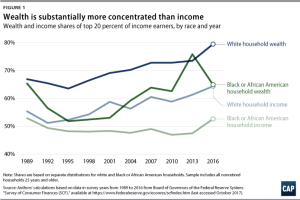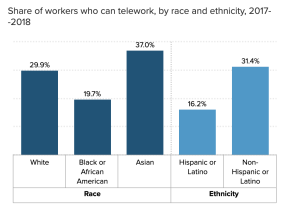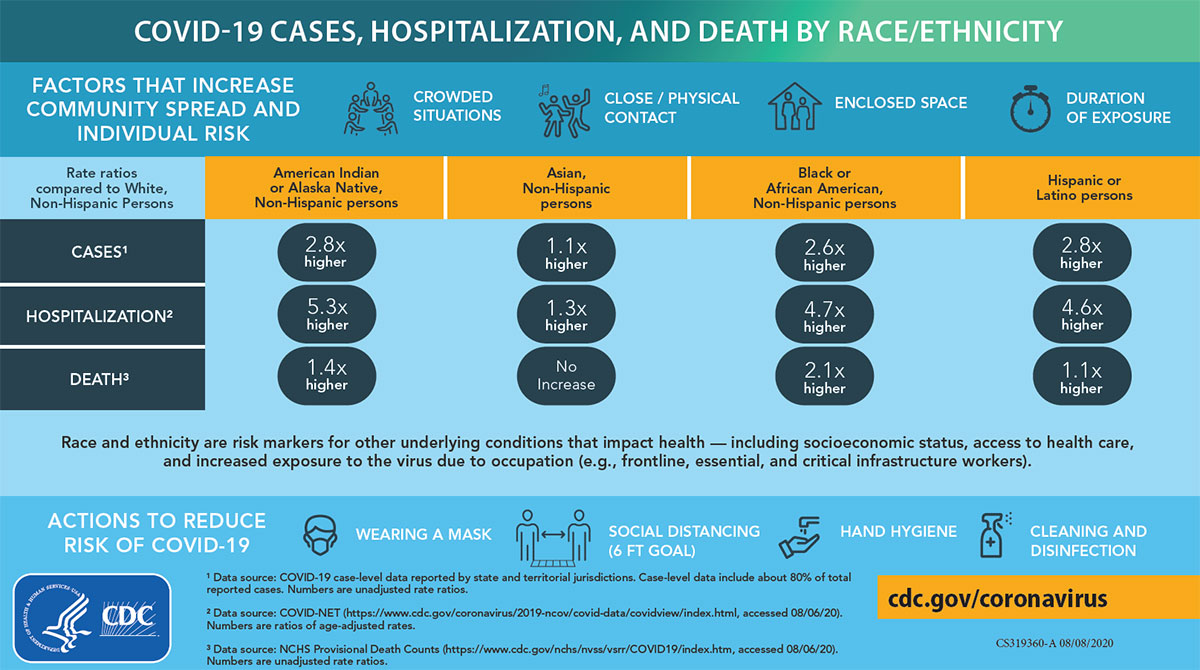14
Lauren Oliver
Introduction
Keywords
Underlying conditions
Comorbidity
Systemic racism
Poverty
Xenophobia
Learning Objectives
- Impact of underlying health conditions
- Socioeconomic status of minorities compared to the majority
- Impact of systemic racism
- Xenophobia
Over the past six months, COVID-19 has taken the United States by storm. Numerous things have been brought into the light that were ignored for too long. Minorities have been impacted the worst by COVID-19. Many individuals have died due to the disease. Black individuals face underlying health conditions that make their chances of surviving COVID-19 decrease drastically (Alcendor 2020). They have also been subject to racial injustices that have increased dramatically this year. Black lives matter protests continue to take place now to dismantle systems that have been set up against them.
Hispanic Americans have also been tested by COVID-19 health wise and economically. They have experienced the worst of unemployment rates racking up 18.2% of them being unemployed currently. Individuals in the Hispanic and Black community make up 40% of the workforce in retail and service industries (Couch 2020). These jobs are seen as essential, so many are unable to work from home and have to work in large crowds. Many companies are only offering limited PPE, no sick pay, or any hazard pay. This makes it hard on minorities to find affordable housing, so are stuck with living in overcrowded dwellings that are more susceptible to COVID-19.
Asian Americans this year experienced some of the worst racism since the 1940s when Pearl Harbor took place. They have been targeted by xenophobic individuals that have harassed them in the public such as grocery stores and community parks. These attacks have gotten violent in some cases. The media outlets have only made matters worse in the United States by inciting xenophobia of Asian individuals. It has created an unsafe space for Asian individuals because many blame them for Asian individuals having also lost most of their businesses from losing customers due to racism brought on by COVID-19.
Overall the medical, social, and socioeconomic impacts of COVID-19 have disproportionately affected minorities.
Black Americans
Key Takeaways
Underlying Health Conditions
Black individuals deal with many underlying health conditions that have been known to increase your chances of dying if being infected with the Coronavirus disease. The popular diseases that most suffer from are Type 2 diabetes, hypertension, and cardiovascular. Type 2 Diabetes (T2D) is one of the main diseases that affects the Black community. Higher rates of T2D can be seen among minorities to be more specific, 80% of youth with T2D come from a minority background (Alcendor 2020). COVID-19 has had a greater impact on individuals with T2D since they aren’t able to control their glycemic response which can affect their: pulmonary function and immune responses.
Hypertension is most prevalent in the United States, affecting 41% of Black men and 41.5% of Black women. Hypertension is the most common comorbidity associated with the most severe complications from COVID-19. In a study of COVID-19 cases, 30% of the cases dealt with hypertension and had the most severe complications from COVID-19. It was absorbed that mortality associated with COVID-19 was higher among Black and Hispanic individuals compared with non-hispanic whites (Alcendor 2020). If you look below at figure 1. It will show you a clear impact of the underlying conditions on individuals.

“Leading comorbidities among COVID-19 deaths in New York” by New York State Department of Health is licensed under CC BY 4.0
Socioeconomic status
COVID-19 has eminently impacted the Black community medically and economically. Twenty-two percent of Black Americans are currently living in poverty (Tai 2020). Only 20% of the Black population are able to work from home compared to the 30% of their white counterparts that are able to (Gould 2020). The median wealth of a Black family is more than 10 times less than the median wealth of a white family. It has become increasingly evident that race/socioeconomic status of individuals affects their access to quality health in the United States. This could be the defining factor in contracting COVID-19 and may determine whether they survive.

“Black or African American households have increasingly faced systematic obstacles to building wealth” by Board of Governors of the Federal Reserve System is in the Public Domain
Systemic racism
This year Systemic racism has gained a lot of interest in the current climate of the United States with racial injustices taking a large toll on the country. Systemic racism is a form of racism that is embedded as normal practice within society or an organization. It can cause discrimination in criminal justice, employment, housing, health care, political power, etc.
Redlining is a system that was used by banks and real estate in the 20th century to determine which neighborhoods would get loans to buy homes. Black people resided in an area that was purposely outlined in red ink deeming it too risky to invest in. This prevented Black families from amassing and maintaining wealth in the same way that white families could.This resulted in the growth of the racial wealth gap and housing insecurity which persists today.
Housing was another factor that was affected by systemic racism. Due to low wages and lack of affordable housing options. Many Black individuals resided in racially segregated neighborhoods that had experienced disinvestments. Communities with higher minority populations are more likely to be targeted for marketing of unhealthy products like alcohol, cigarettes, and fast food. There was overcrowding in these communities which increased transmission and exposure of COVID-19. This influenced the chronic medical conditions found in the Black population such as type 2 diabetes, hypertension, etc. In these predominantly Black neighborhoods, hospitals are more likely to close down in that area than hospitals in predominantly white neighborhoods (Fleuh, 2020).
Racial Injustices was systemic racism’s focal point. Numerous instances have taken place relating to racial motivated murders. Such as the deaths of: Ahmaud Arbery, Breonna Taylor, George Floyd, Tony McDade, and Elijah McClain to name a few that were killed this year. Black Lives Matter protests took place across the globe this summer and were broadcasted on all social media outlets. There was a clear divide between the country at that point.
Overall Systemic racism played its role in COVID-19 because many Black individuals do not have the privilege to work from home or live in a less crowded building. They have to deal with it and try their best to survive with what they have and is why Black people have the highest death rates of COVID-19 in the U.S.
Hispanic Americans
Key Takeaways
Socioeconomic status
Overall 33.8% of the COVID-19 cases were of Hispanic descent and only comprises 18% of the United States population (Tai 2020). Hispanics experienced the highest rate of unemployment ever recorded for their descent. 18.2% of their population was jobless. There was a high concentration of Latinos in retail and construction industries that dealt with high rates of unemployment. This made them more susceptible to immediate layoffs that took place because of COVID-19. Those who weren’t laid off dealt with: working in large crowds if working in retail/service fields and traveling in crowded public transportations. 16.2% of the Hispanics population did not have the privilege to work from home which put them more at risk to contract COVID-19 (Shierholz 2020).

“Less than one in five black workers and roughly one in six Hispanic workers are able to work from home” by U.S. Bureau of Labor Statistics is licensed under CC BY 4.0.
Communication gaps
In this pandemic it was very hard for individuals in the Hispanic community that didn’t speak english well to understand what was really going on. Many news sources were not spreading information suited for those who spoke different languages. This led to lack of credible COVID-19 information reaching the marginalized communities. This elevated their risks of disease contraction and transmission. Many did not know what was really happening and the severity of the situation at stance in the country. It could possibly explain why there were so many Hispanic individuals that died in the United States.

“COVID-19 CASES, HOSPITALIZATION, AND DEATH BY RACE/ETHNICITY” by Center Of Disease (CDC) is licensed under CC BY 4.0
Asian Americans
Key Takeaways
Socioeconomic status
Asian Americans have been affected economically by COVID-19. 13.7% of the Asian population were unemployed after April 2020. Over 223K small businesses run by Asian individuals were closed down (Couch 2020). Numerous Chinese restaurants temporarily closed due to a decrease in patronage and hostile remarks from individuals. Asian Americans have been subject to racism because of the location that COVID-19 originated in which was Wuhan, China.
Social status
White house officials and news outlets coined the term “Chinese virus” and “Kung-flu” regarding to COVID-19. It has aided in normalizing anti-Asian xenophobia within the United States. It has stoked public hysteria and racial motivated attacks against Asian/Chinese Americans. The media outlets and social media have only added fuel to the issue. Many memes have been created to create a mockery of the disease and how it is all Asian and Chinese individuals fault for it entering U.S. borders. News outlets haven’t helped either using headlines such as: “Chinese virus pandemonium” or “China Kids Stay Home”. These things have caused 2,600 reports of discrimination towards Asian Americans have been collected since March 2020. Numerous Asian citizens have been spat on in grocery stores, harassed while jogging being called vulgar names. It has even gotten to the point when these attacks have gotten violent in certain cases (Cheah 2020).
Chapter Summary
- Black Americans
- Individuals in the Black community have dealt with disproportionate rates of COVID-19 cases in their community, while also dealing with systemic racism and the role it plays every day in their lives.
- Hispanic Americans
- Hispanics have lost a lot due to COVID-19 because many were left unemployed and a lot were infected by the virus. This was due to lack of information about COVID-19 reaching these marginalized communities.
- Asian Americans
- Asians dealt with a lot of xenophobic and racist individuals that caused them to be attacked in public and lost many of their small businesses. News tabloids and racist remarks made by top officials caused these racial attacks.
Review Questions
- What are some examples of underlying health conditions found in Black individuals?
- a) Hypertension
- b) Type 2 diabetes
- c) Cardiovascular diseases
- d) All of the above
- What percentage of Hispanic Americans are unemployed?
- a) 18.2%
- b) 20%
- c) 50%
- d) 25%
- How many discrimination reports against Asian Americans have been made since March?
- a) None
- b) 4,000
- b) 2,600
- d) 2,900
- What are some ways that systemic racism has played a role in the world currently?
Answers
- D
- A
- C
- Ex. Systemic racism can be seen in the housing markets and the criminal justice institutions, etc.
Reference lists
Alcendor, D. (2020, July 30). Racial Disparities-Associated COVID-19 Mortality among Minority Populations in the US. Retrieved November 24, 2020, from https://www.mdpi.com/2077-0383/9/8/2442/htm
Cheah, C. S. (2020, September). COVID-19 Racism and Mental Health in Chinese American Families. Retrieved November 24, 2020, from Racism_and_Mental_Health_in_Chinese_American_Families/links/5f5bebf44585154dbbcb27f6/COVID-19-Racism-and-Mental-Health-in-Chinese-American-Families.pdf
Couch, K., Fairlie, R., & Xu, H. (2020, September 14). Early evidence of the impacts of COVID-19 on minority unemployment. Retrieved November 24, 2020, from https://www.sciencedirect.com/science/article/pii/S0047272720301511
Frueh, S. (2020, July). COVID-19 and Black Communities. Retrieved November 24, 2020, from https://www.nationalacademies.org/news/2020/07/covid-19-and-black-communities
Health Equity Considerations and Racial and Ethnic Minority Groups. (2020, July). Retrieved November 24, 2020, from https://www.cdc.gov/coronavirus/2019-ncov/community/health-equity/race-ethnicity.html
Oppel, R., Gebeloff, R., & Rebecca, K. (2020, July 05). The Fullest Look Yet at the Racial Inequity of Coronavirus. Retrieved November 24, 2020, from https://www.nytimes.com/interactive/2020/07/05/us/coronavirus-latinos-african-americans-cdc-data.html
Pan, D. (2020, June 3). The impact of ethnicity on clinical outcomes in COVID-19: A systematic review. Retrieved November 24, 2020, from https://www.thelancet.com/journals/eclinm/article/PIIS2589-5370(20)30148-6/fulltext
Not everybody can work from home: Black and Hispanic workers are much less likely to be able to telework. (2018). Retrieved November 24, 2020, from https://www.epi.org/blog/black-and-hispanic-workers-are-much-less-likely-to-be-able-to-work-from-home/
Racial inequalities in COVID-19 – the impact on black communities. (n.d.). Retrieved November 24, 2020, from https://www.medicalnewstoday.com/articles/racial-inequalities-in-covid-19-the-impact-on-black-communities
